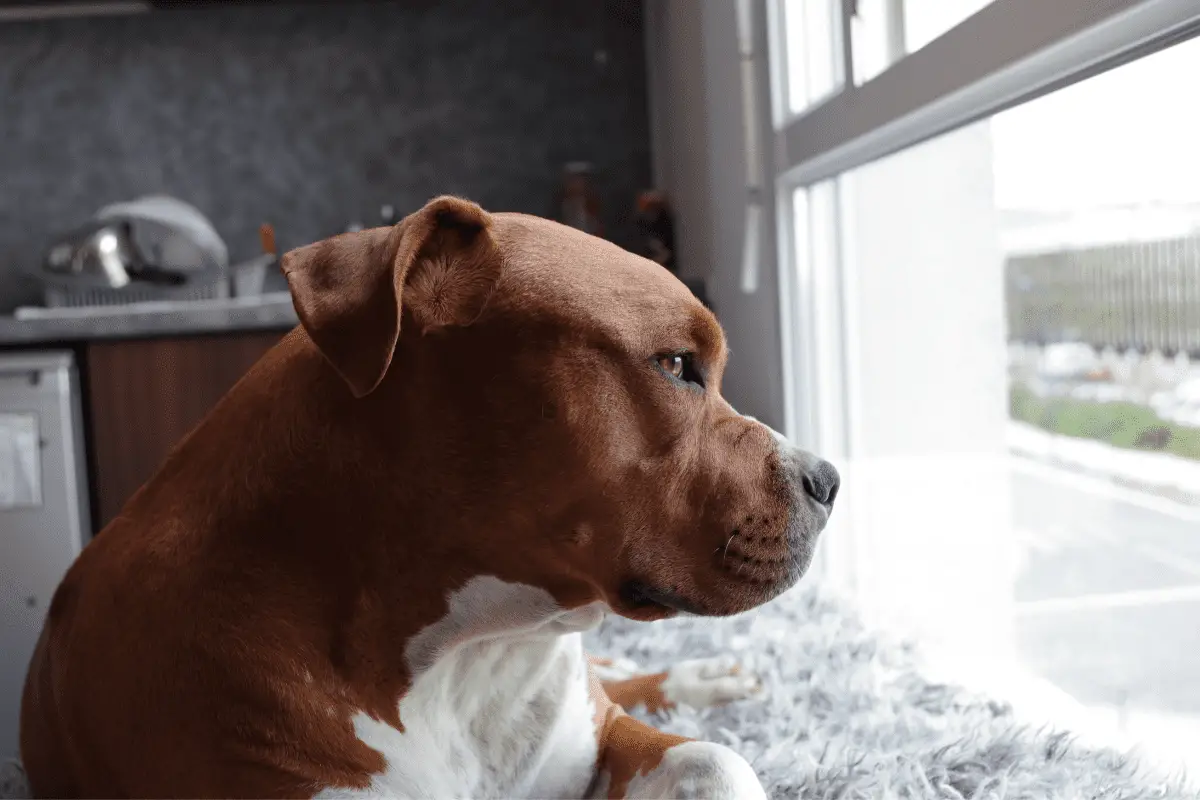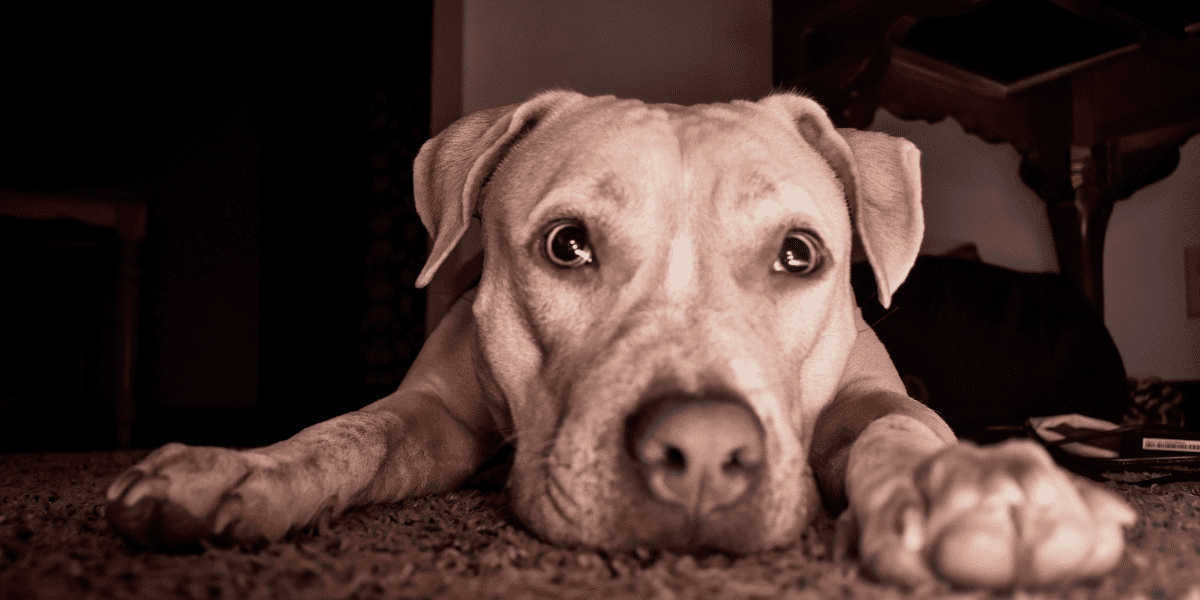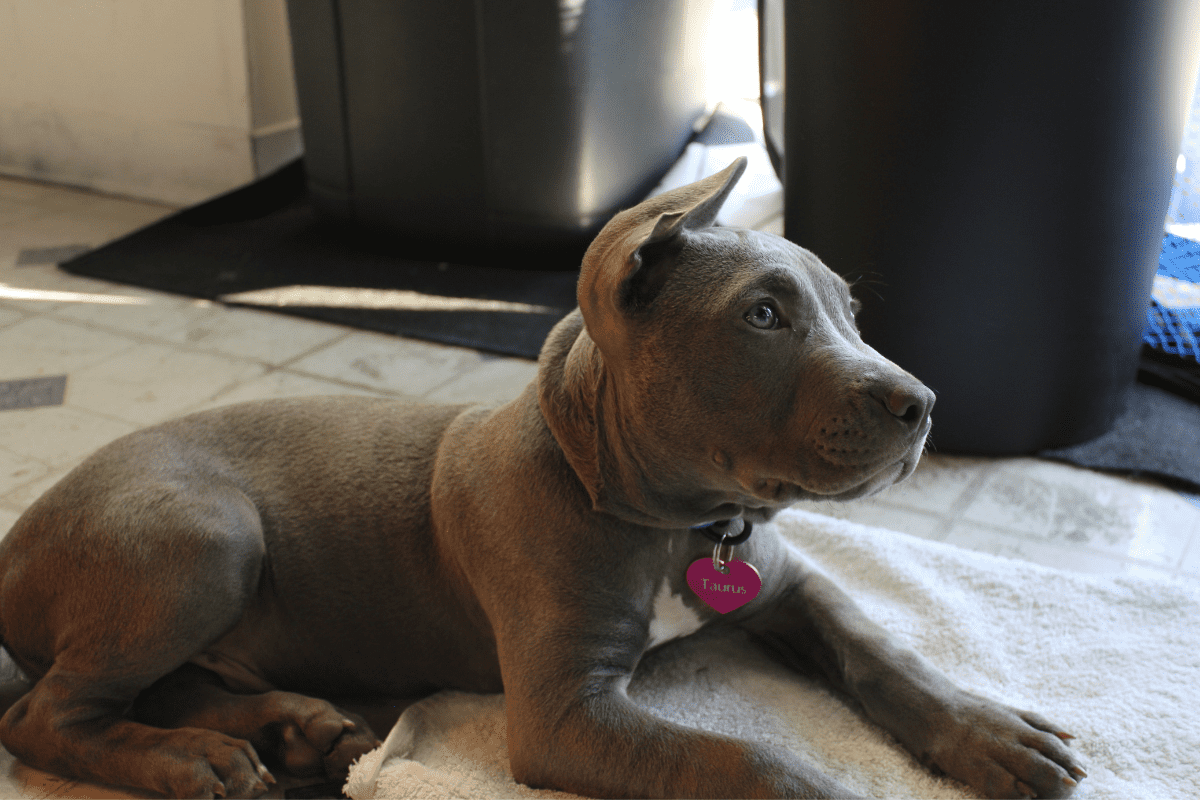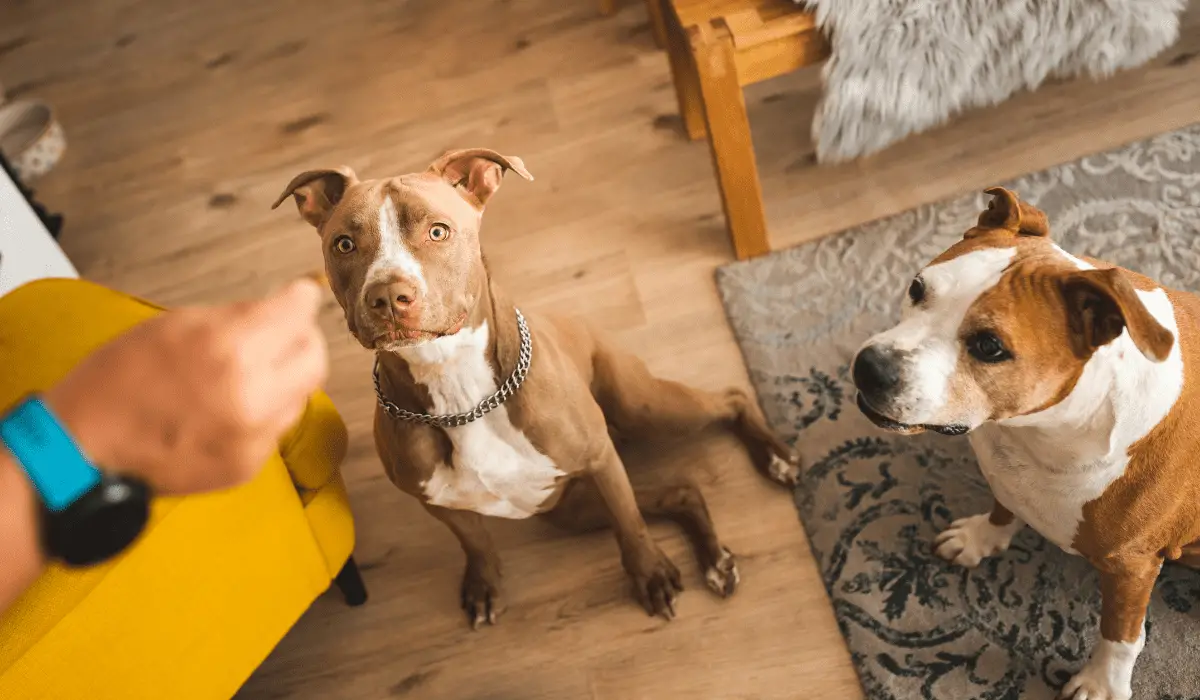Separation anxiety is among the most common reasons dogs wind up in shelters.
But if your pitbull exhibits signs of separation anxiety, there’s no reason for him to suffer such a cruelly ironic fate. While breeds that bond most closely with humans, such as the American Pit Bull Terrier, may have a slightly higher predilection for developing separation anxiety, nearly all of these cases are treatable.
You just have to find the solution, or combination of solutions, that work for your dog.
Do Pitbulls Have Separation Anxiety?
Yes, Pitbulls can have separation anxiety. Separation anxiety is a natural fear that dogs can develop, especially if they are left alone frequently.
This can be troublesome for owners who work long hours or have other obligations outside of the home.
If you own a pitbull, you might be panicking right now thinking about the fact that this breed has a tendency to get separation anxiety more than most other breeds.

But don’t worry! There are steps you can take to prevent it from getting to this point or recover if your dog has developed separation anxiety as a result of your frequent absences.
Here are some indicators and tips on how to handle your pitbull’s separation anxiety.

Get the 7 Biggest Training Mistakes free report!
Pitbull Separation Anxiety Signs
1. Changes In Behavior
The first thing to look out for if you believe your dog has separation anxiety is changes in behavior.
If your dog has always been calm around you and your family, but suddenly begins to cower, hide or show signs of nervousness when you are around, this could be a sign that something medical is wrong with your dog.
It’s a good idea to see a veterinarian to rule out this possibility. If your dog has always been anxious when they are left alone and suddenly cries or acts out when you leave, this is likely a sign of any one of three things:
- Separation Anxiety: anxiety specifically about the owner leaving.
- Containment Phobia: similar to claustrophobia in humans.
- Self-indulgent behavior: a dog (typically adolescent age) who is just upset about not being the center of attention at the moment.
It’s important to make the distinction of what type of anxiety your dog has before proceeding.
If you’re unsure, most dog trainers will perform a behavior consult for free or for a small fee.

2. Excessive Drooling
If your dog’s anxiety begins to manifest itself physically, you may notice an increase in drool. The reason behind this is that dogs drool when they are anxious because they are secreting excess saliva.
They do this to keep themselves calm because saliva contains natural opiates that are somewhat relaxing.
3. Howling, Whining, And Barking
Perhaps one of the most clear-cut signs that your dog has separation anxiety is excessive howling, whining, and barking, especially if your dog cries for long periods of time.
If your dog only whines and cries for a few minutes, however, anxiety isn’t likely. It’s common for a spoiled dog to be offended when you leave him. He wants to make sure you are aware of his disapproval.
This is not the same thing as separation anxiety.
4. Stimming Behavior
If your dog begins to spin in circles, jump up and down or pace around the house, it could be because of anxiety.
This type of behavior is referred to as “stimming”. It is a way that dogs with separation anxiety attempt to self-soothe when in distress.
Chewing is also a stimming behavior. This is often very disruptive and can cause a lot of damage around the house.
You may also notice damage to entry and exit points in your home like doors and windows.
This could indicate a containment phobia problem (i.e. claustrophobia).
5. Urination, Defecation, And Excess Eating
If your dog urinates or defecates excessively when left alone, and frequently has loose stools or diarrhea, it could be a sign of anxiety.
In many cases, dogs with separation anxiety will urinate, defecate, or chew things when left alone.
This is because they are experiencing extreme anxiety which can cause stomach upset and explains the urinating and defecating.
Possible Causes Of Separation Anxiety
In some cases, separation anxiety is precipitated by a particular event, such as the death of a beloved pack member, someone moving away on a permanent basis, being left at a shelter, or getting lost.
But there are many instances where no one will ever know why a particular case of separation anxiety developed.
Solutions For Pitbull Separation Anxiety
Regardless of the cause, here are a few methods you can start using right away to treat separation anxiety.
- Practice Leaving (progressive desensitization)
- Crate Training
- Increased Exercise
- Calming Remedies
- Get a second dog
Practice Leaving: Progressive Desensitization
Start by entering the room where you plan to leave your pitbull, tell her to stay, and walk out. Close the door behind you. Then immediately come back in. Don’t make a big production out of coming and going, treat everything as matter of fact.
Continue practicing this routine, never leaving the room for more than a few seconds at a time, until your dog no longer acts anxious when you leave or return.
Gradually increase the length of time you leave your dog alone, and how far away you go. At first, stay in the house. The next step is to try going outside into the yard. Soon, you’ll have worked your way up to getting in the car and driving around the block.
Once you get past an hour or two hours, and your dog is no longer anxious, there’s a good chance she’ll be fine for a whole day. Before you leave your dog alone for this length of time, however, you might want to hire a pet sitter or pretend to leave while actually staying in another part of the house.
This way you’ll be sure of her safety before you leave her on her own for an extended period of time.

There are two important techniques you should employ as you make your absences longer.
- Vary your timing.
- Use cues.
Varying your timing is important because you don’t want your dog to think each new absence will always be longer. That could cause anxiety all by itself if she starts doing the math. The more extended her time alone becomes, the more often you want to surprise her by coming back early.
Cues provide an important tool to relax your dog. You might always turn on the radio, or give him a stuffed Kong or a favorite snuggle toy, when you leave for your brief absences. In your pitbull’s mind, this cue will soon become associated with the assurance of your prompt return.
At the same time, desensitize your pitbull to other cues that he associates with long isolation. Make a habit of picking up your keys or putting on your coat, and then not leaving. That will de-emphasize the stress factor associated with those behaviors.
Crate Training
There are four obvious advantages to crate training.
- Your pitbull can’t tear up the house in the crate.
- Your dog can’t accidentally get into anything toxic in the crate.
- Dogs feel more secure in den-like environments such as crates.
- The first three benefits manifest immediately, without extended practice time.
The best kind of crate to get for separation anxiety purposes is the plastic, airline approved Vari-Kennel type. A panicky pitbull might be able to dismantle a wire crate from the inside, either releasing himself or hurting himself in the process, and possibly increasing the panic factor. Plastic crates, on the other hand, are the safest place to be even during an earthquake.
Your pitbull won’t get out and is less likely to hurt himself in the crate than whole roaming the house in a panic.
While eliminating property damage and the risk of getting into the cleaning products are obvious short-term benefits, crates can also be great for your pitbull’s long-term psychological health.
Dogs feel more secure in caves and dens, and they feel more secure in crates. Anyone who leaves their dogs’ crates open can tell you that dogs voluntarily curl up in crates throughout the day and night, even when they have the run of the house.
The same is sometimes true of closets, but who knows what your dog can get up to in the closet? And really, leaving your dog in the closet just seems tacky. Go with the crate. Ideally, leave your dog with a stuffed Kong toy or something similarly safe for unsupervised chewing to help pass the time while you’re gone.
Obviously, being in a crate won’t directly prevent barking or self-mutilation activities.
However, the lowered anxiety levels in a crate may also reduce the likelihood of these behaviors. To really be confident of eliminating them, combine crate training with progressive desensitization.
Increased Exercise
Anxiety takes a lot of energy. And bored dogs are more likely to be anxious. Reduce both boredom and energy levels by greatly increasing your dog’s exercise levels, and you might lessen her separation anxiety.
This is especially true when the tiring, fun exercise takes place right before you leave.
It’s also worth mentioning that many dog owners think their pet has separation anxiety, when in fact the dog is just restless and bored. In these instances, the symptoms of separation anxiety may be completely cured by increasing exercise levels.
Even in cases of genuine high-grade separation phobias, exercise provides an excellent, and in some cases a necessary, complement to other methods of reducing anxiety. Plus, it’s good for your dog’s physical health, and yours.
Calming Remedies
Some dog owners have had good results adding natural calming remedies to the behavioral suggestions for combating separation anxiety. Some things you can try:
- Homeopathic Remedies (try a combination remedy formulated to soothe the nervous system such as PetCalm or have a homeopath prepare a constitutional remedy specifically for your dog)
- Flower Essences (Bach’s Rescue Remedy is the best-known flower essence for anxiety, but there are others as well)
- Herbs (try kava kava, passion flower, valerian root, skullcap, and/or chamomile)
- Essential Oils (try using a blend of German chamomile, lavender, and other calming essential oils in an aromatherapy diffuser while you’re gone)
Get a Second Dog

Many dogs feel more comfortable as long as anyone is there with them, including another dog. If the other dog is an accepted and trusted pack member, all the better.
Do keep in mind that with pitbulls, you need to be sure you crate the dogs separately when you leave. This goes triply when introducing a new dog into a high stress situation like separation anxiety.
Also, make sure your pitbull is okay with the presence of another dog before you formally adopt. The same rules apply as with any other time you add a new dog to the household.
Extremely Severe Cases Of Separation Anxiety
If your dog is destroying your house and engages in self-mutilating behavior while crated, you can’t wait for therapeutic techniques to kick in.
Assuming you have to depart the house during this period, and exercise and calming remedies fail to curb the behavior, you may have to leave your dog with a competent and caring friend, family member, or pet sitter while you’re away.
You can also try a boarding kennel. But keep practicing progressive desensitization and crate training. Eventually, your dog will almost certainly come around.
What NOT To Do
Finally, here are a couple of things to avoid doing.
Never punish your dog for exhibiting signs of separation anxiety! Punishing your pitbull for being distressed when you leave is wrongheaded for many reasons, but the one that should get through to everyone is that it doesn’t work.
Punishment exacerbates the problem. Fear of being punished when you return gives your dog one more reason to panic when you leave.
And second, if your pitbull has a tendency to destroy property while you’re away, don’t point out the items you especially wish to keep safe before you leave. Your dog could misinterpret you and think these items need special attention during the chewing frenzy.
Or, because dogs, like people, tend not to be entirely rational when they are panicking, your pitbull might think something along the lines of “Aaaaaaaahhhhhhhh! They left me theyleftmetheyleftme! What do I do what do I do whatdoIdo SOFA! I remember they pointed out the sofa MUST POUNCE NOW sofasofasofa — Wait. Where did the sofa go? What happened? What is this mess all over the floor where the sofa used to be? Oh no whatdoIdo Garbage! They pointed at the garage before they left!” And so forth.
While separation anxiety can result in injury to your dog, massive property damage and furious neighbors, even the most severe cases can usually be cured with proper training/treatment.
Crate training can stop the property damage right away, and a variety of effective techniques exist that you can use to reduce your pitbull’s anxiety, leaving both of you happier and (at least relatively) stress-free.
Pitbull Separation Anxiety Final Thoughts
If you notice any of the changes mentioned in this article, it is important to take action.
Otherwise, your dog’s anxiety will worsen and could even lead to them developing serious psychological issues.
The best way to treat separation anxiety in dogs is to employ the help of a trainer who understands behavior modification strategies.
Separation anxiety is a serious problem that justifies hiring a dog trainer. This means you will have to spend some time retraining your dog to reduce their anxiety.

Mindee,
I know your original
Mindee,
I know your original question was a couple of months ago, but I’m hoping you still have your dog and that I might be able to help. First, I applaud you for keeping your dog. Taking her to a shelter that is already overloaded just makes her someone elses problem. Dogs with her energy level can and do lose their minds in a kennel at a shelter and they aren’t a potential adopters first choice because they’re hyper, anxious etc. So they sit there longer than most and it sometimes does irreversible damage to them. Lots of times when they do get adopted they are quickly returned because of their energy level. I speak from years of shelter experience. Keeping your furry family member and working through her issues is by far the BEST thing for her. My first thought for your situation is that an invisible fence may help greatly. You can run it around the perimeter of your fence and set the footage so that it keeps her several feet away from the fence. With proper training (instructions included with the fence and collars) these work really well. It first gives a beep to let the dog know that they’re getting too close to the fence….then if they ignore the beep, they get a shock from their collar (the strength of the shock is at your control, by a setting on the collar). Most dogs don’t have to be shocked more than once to learn that they don’t want it to happen again and they stay away from the perimeter after that. Because of her breed mixes, I’m sure she is an extremely intelligent dog and this type of fencing would work great for her. This would allow her to run free in your yard and burn off the energy she has, but not be able to jump the fence and put herself in harms way. Being chained up can make even the best dogs go crazy, even if it’s for short periods of time. You could also run the invisible fence line to keep her away from the windows/doors that she may try to jump through and train her that those areas cannot be approached until you’re with her and her collar has been removed. I would also consider getting her toys that stimulate the brain. There are kongs and other types of toys that you can put treats or food inside and the dog has to work to get it out and they can keep a dog busy for a long period of time. Also, please consider using flower essences, herbs, rescue remedy and other natural products that can help to keep her calm. Most importantly, please remember….what is rewarded is repeated. Find her favorite, most coveted treat and work with her. Sit outside with her and wait for those noises that would normally set her off….keep her close and calm and wait for her to stay quiet and ignore the things that normally cause her to bark or freak out. This will be hard at first, but be patient. The very first time that she hesitates….even for a second….give her a treat and tell her what a good girl she is. Repeating this will cause those seconds to last longer and I promise you….eventually she will stop reacting to those things. She’s reacting the way she is because those sounds are stimulating to her and it’s like "play" in her mind….her barking and reacting to those things are her reward. I’d love to know how things are going for the both of you and have many other thoughts and suggestions if you’re interested. 🙂
I am new to this whole dog
I am new to this whole dog thing and i do live in an environment where he is only in my room. However I take him out several time let him play for a few hours on the eash outside but he still hates when I leave. Now that I am starting school and im gone for 4 hours is it wrong to leave him in the crate for that long?
I used to crate Marley all
I used to crate Marley all the time when he was younger. He did very well but, when we moved to a new place, it made him nervous and he now goes nuts in the cage. I have tried mostly everything. Drugging him seems mean but, I am too that point. My question is, is it something I will have to do all the time? The problem is, I now live in an apt. complex and he screams like someone is murdering him when left alone. We have had several complaints so I need a quick fix now before we’re both homeless.
I want to say I probably was
I want to say I probably was a bit nasty, I apologize, I have just reached the end of my rope and it hurts to think what may happen to her, I have had her since she was born and she has become my baby. I don’t understand what is up with her because we had lived in town before and she was just fine, the only time we had trouble with her was 4th of July foreworks and bad summer storms and when a cat got in the yard and she almost got it, but other than that she was just fine. I realize that I may need to find her another home but here in my town there is only the dog pound, a kill shelter, I will not do that to her, but I am going to start walking them more and maybe it will help, thank you for your feedback, I love my girls and I get a bit sensitive when I think of getting rid of them. I am hoping I can find a solution soon.
Yes, Mindee, I am sure that
Yes, Mindee, I am sure that you do love her. I even said, “I know you love her, but this dog does not sound like it is the right one for you.” The point you made when you said that you cry when thinking of giving her up proves that. Also, when I mentioned about giving her love, I was going on what you said in your original message because it sounded as if she was chained on a constant basis (your words, “Anyway in the daytime if she hears the neighbor open their patio door or hears them talking in their own house she goes bonkers…and “she is fine at nite tied outside does not bark unless there is cause“). It sounded as if you had her chained 24 hours a day outside. I now know better.
However, I stick with what I say about her not being the right dog. Neither her or her mother sound as if they are getting enough exercise (the mother chews and paces). It’s not something to be ashamed of, there are times when people can’t take care of their dogs for one reason of another. You had to move, which is out of your control. You said it wasn’t a problem when you lived in the country, but now circumstances have changed. I also don’t agree with dropping dogs of at shelters, especially when they are kill shelters. However, there are still no kill shelters with foster homes (I adopted my dog from a “no kill shelter” that rescued her from a “kill shelter”). I know it would be horrible giving them up, but what is best for the dogs (especially, a pit bull, German shepherd, and border collie mix)? Maybe a less intense dog is better for you and more suitable for the location where you now live.
Again, I will state this, if you find that you can take care of the dogs, look into Caesar Milan’s body of work (aka “The Dog Whisperer”). He has plenty of strategies for the problems you are having. I apologize for offending you, and I wish you the best in solving this dilemna.
I need help, I have a 4 year
I need help, I have a 4 year old 1/2 pit 1/4 border collie 1/4 german shep. mix. I love her but she is driving me crazy and I don’t know what to do, she is fine at nite tied outside does not bark unless there is cause, I have to keep her tied because she likes to jump the fence and through windows. Anyway in the daytime if she hears the neighbor open their patio door or hears them talking in their own house she goes bonkers, clawing at the ground hitting the end of her chain barking and whining, or even if she hears voices down the street its the same thing. I cannot tie her close to the house or anything wood or she will eat it and if she is near a window she will jump through it like last week and cut herself, thankfully it wasn’t bad, also she hates cats but I guess thats normal? So I know she doesn’t get enough exercise but it is difficult to walk her anywhere because she is agressive towards other dogs/animals, we also own her mother whom is also nervous but she just paces and will eat the house if she can. We had a chiweenie dog that I was keeping for my niece for about 2 years then she took her back, her and my pit were best buds now she wants to attack her, Anyway any opinions? I love my doggy I just don’t know what else to do?
Most of the problem is that
Most of the problem is that your dog isn’t exercised and worst of all, is chained constantly. Please think about this, she is not exercised, so she is looking for a way to get rid of all the energy she has. If dogs are not exercised, they try to find stimulation however possible. Also, your dog is part German shepherd and border collie. Your dogs are mixed with some of the most energetic and intelligent breeds. They are working breeds, which means they need a job to do constantly and will become destructive if not stimulated. Border collies should NEVER be in a urban or suburban setting, which sounds as if you live in one of these areas. They need plenty of space like in a rural setting. My neighbors dog is part border collie, and barks constantly (which is annoying to the neighbors as well) because she is on a chain or in the house day and night. It never gets exercise. I don’t mean to be harsh, but this dog does not sound like it is the right one for you. I know you love her, but giving it to someone that can properly take care of her sounds like the best thing for her.
If you are serious about keeping her, she needs exercise immediately. I would suggest watching “The Dog Whisperer,” getting some of his videos, and/or reading his books. His sources will be helpful in dealing with a high energy and also an aggressive dog.
One last point, I don’t know if this is the case, but dogs need love also. If she is chained up all day and night away from you, she is not getting the love she needs. And please be careful in you live where it is hot in the summer or cold in the winter. Leaving your dog outside in harsh conditions could kill her.
I want you to know sir I love
I want you to know sir I love my dog very much and I do play with her and am always hugging her and playing catch with her, I keep her chained up because I have no choice, she wants to chase anything that moves, and will jump through glass windows, if I didn’t love her I would dump her at a shelter, she is my baby, and we lived in town before and never had this problem, we just moved here, I can’t afford to live anywhere else. If someone could take her and never have to tie her up I would give her up but she is chained for her protection too and also sleeps in the house almost every night especially in extreme weather. I appreciate your suggstion but please do not think for one second I don’t love her enough, I have cried when I think of giving her up. Her favorite spot in the summer is in front of the ac and the heater in the winter, I would never leave her out in extreme weather, she also has a huge water bucket that she can lay down in and yes clean water to drink, with ice in a seperate bowl, but I don’t love her? Yea right, I need some help yes but do not accuse me of not loving her.
my dog gets like this when
my dog gets like this when she doesn’t see the person coming and hears them first. you should take her for long walks in the woods, and if she’s good and listens to your commands then let her off the leash to run around and she won’t be so hyper so she won’t really care as much. and try to expand her sight because i think its because she gets startled by the people.
My baby had a real problem
My baby had a real problem with me leaving her. She wouldn’t eat or go outside if I wasn’t home, my husband was there with her at night but she just ignored him. I gave her my pink blanket to sleep with and I leave the TV on for her. It has helped a lot!!! We have another pit bull but he is crated when we leave, she usually lays by him and they watch tv till we get home. She hasn’t ate anymore of my furniture in about 2 months. 🙂
My 6 year old pit developed
My 6 year old pit developed this when we moved into a new house 2 years ago. It kicks in during the summer when we have our afternoon thunderstorms here in Florida. The vet put her on medication called reconcile. It seems to work a little, but doesn’t last that long. She knows how to get out of the sliding glass doors, with the pin in, wood in place on the floor and double locks. We have replaced every single pair of blinds in our house twice and now going on a third time for a few sets. Thank God for good neighbors who take her in and know that she is a good dog. She breaks out of crates and gets more anxious in the crate, so that doesn’t work. We FINALLY found a solution, clamp locks holding each sliding glass door in place so she cannot break out and we keep the front window blinds half way up so she can sit on the bed and look out. Watching us drive away seems to put her at ease sometimes. This is a very difficult thing to deal with!
I have a question. My dog is
I have a question. My dog is crate trained and behaves excellently when I leave our home…the problem I have is when we visit a strange place like someone else’s home and I need to crate her for a short period of time…she goes absolutely bonkers. How can I remedy this situation?
Familiar smells from familiar
Familiar smells from familiar environments. Does she have her favorite toy, blanket, or pillow?